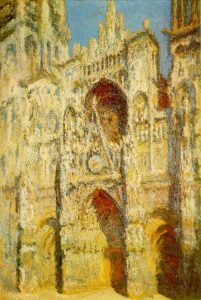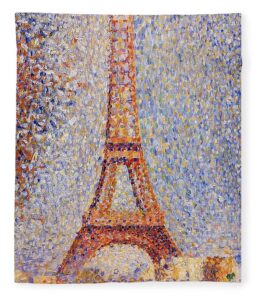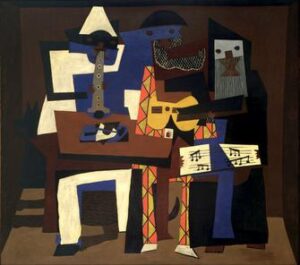About an Aesthetic Realism lecture on the relation of the arts and sciences, including a discussion of movements in the history of art, and surprising relations to other fields of study
 The lecture I’m reporting on was the 9th in a series Eli Siegel gave on the relation of the arts and sciences. This talk, of January 10, 1969, was one of the grandest things I’ve ever heard. These two subjects—art and science—have battled intensely in the history of thought, and a person today can feel she is in different worlds as she may be moved by a portrait she sees tomorrow at the Metropolitan Museum, and then, on Monday, feel this emotion is so far away as she sits at her computer, analyzing data. In this lecture, with clarity and ease, Mr. Siegel showed how science and art, fact and feeling, are deeply inseparable.
The lecture I’m reporting on was the 9th in a series Eli Siegel gave on the relation of the arts and sciences. This talk, of January 10, 1969, was one of the grandest things I’ve ever heard. These two subjects—art and science—have battled intensely in the history of thought, and a person today can feel she is in different worlds as she may be moved by a portrait she sees tomorrow at the Metropolitan Museum, and then, on Monday, feel this emotion is so far away as she sits at her computer, analyzing data. In this lecture, with clarity and ease, Mr. Siegel showed how science and art, fact and feeling, are deeply inseparable.
He used as his text something surprising: the 1957 Catalogue of the 68th Exposition of the Société des Artistes Indépendants—the largest showing of art in France, which gives hundreds of artists from Paris, the provinces, and abroad a chance to exhibit their work. Mr. Siegel noted that the Society was founded at the time of Impressionism because it was felt that the customary way of judging art was unjust; and here, they are proud to say, there is no jury. The way Mr. Siegel looked at this catalogue was itself a oneness of science and art, the desire to see facts truly, and to see what those facts mean; it was a rich education in justice to reality. He began by reading, translating and discussing a list called “Définition Succincte des Tendences”—succinct definitions of twelve different schools of art, signed by Henry Valensi. “Within them,” he said, “one can see how science is within art, and art is within science.” First we heard Valensi’s definition of the classique:
Every painter who reproduces faithfully that which exists (or which could exist) and who works according to the traditions and techniques of the Masters of the 16th, 17th and 18th centuries.
“The classique,” he said, “is quite near to the scientifique,” and looking at the words “reproduces faithfully” in the definition, Mr. Siegel explained,
When you reproduce faithfully, you’re in the tradition of science. Every working drawing, every picture that is supposed to be useful for science is a classique. When an engineer designs a new bridge, or a new type of pulley, he “reproduces faithfully'” the object in his drawing. We should see that sometimes the two are very close.
Then, pointing to how the neo-classiques differed from the classiques in “modification of the technique and color,” Mr. Siegel gave a swift and thrilling history of the use of color in painting:

The classiques used color, of course—but they didn’t revel in color. They simply used it. Veronese is less classique than Raphael because Raphael used color, but like a gentleman, while Veronese did a little reveling. Titian did too. The Venetians did more reveling than others. But reveling occurred with Lorrain. And later, a gift of romanticism was more reveling in color. The great reveler-in-color of the 19th century is Turner; and Delacroix is unrestrained. In the 19th century, the seeing of color as a reality in itself came to be.
And he said, “We are approaching the time when color was almost the same as God.” He explained that artists came to feel the color around water could be just as important as the water, and said:
All this belongs rightly to the subject of science, because such matters as water and clouds and air and wind and sun belong to science. Sunlight is a scientific datum, though it is meant to cheer you up.
Aesthetic Realism & the Impressionists
I was stirred by how Mr. Siegel spoke about the impressionists, whose work I care for, and who, Valensi says, work according to the principles of Manet, Monet and others, which are:
1. to attribute apparent colors no longer to objects…, but to light and the reflections that make them luminous; 2. to bring out and hide colorings in shadows; 3. to paint by juxtaposed touches.
Mr. Siegel said this concerns some of the eternal questions of science: “Is the eye only a receptor or does it do something to the object? Is light only passively around an object, or does it do something to the object? Does shadow do something?” He described vividly how Monet’s work shows an intense desire to answer these questions:
Is the eye only a receptor or does it do something to the object? Is light passively around the object, or does it transform the object? Does shadow do something to an object? The things that could happen through oneself or through light concerned the impressionists. And so we have the example of a cathedral looking mostly like feverish grand sunlight, in Monet. Then, we have boats that seem to be boats of wood but seem to be sunlight too. You rowed the sunlight in a Monet boat. Manet is more restrained that way. He isn’t a luminous person, the way Monet was.
Many people in the class, including artists and persons whose field is science, commented on how moved they were by this exact description, which made clear what Monet was after in his now-famous paintings of the Rouen Cathedral. “The eye is both art and science,” Mr. Siegel continued. “[It] does something and also knows something. Art is that which does. Science is that which knows. This has the perils of simplicity, but it’s worth knowing.”

Then, explaining how the principle of painting ‘by juxtaposed touches’ is of science, he said,
[A]rt and science deal with the way an object is made. If we look at a pane of glass, it can be seen as rather continuous. Still, it’s possible to make bits out of glass, to change it into little cubes 1/32 of an inch. Everything can be seen as consisting of lesser wholes within it. Seurat accented the fact that all color is made up of things within it, and they could be juxtaposed.
Realists, Cubists, & More
Of the realistes, Mr. Siegel said the name, “obviously merges art and science.” These are painters who “attempt…to give a reproduction the nearest possible to reality.” Asked Mr. Siegel:
What is the “nearest possible to reality”? That is both an artistic question and a scientific question. Picasso would say, “I go after reality—my reality, but reality.” Darwin would say, “I go after reality which includes me.”
Eli Siegel wanted to see the truth and value of every aspect of reality—in art, in science, and in every person. What he was showing in this talk can end the feeling that science and art, fact and value, logic and emotion are against each other, a feeling that permeates schools and colleges, and does much harm. In high school, I can remember walking out of the microbiology lab, down the stairs, and into the sculpture studio—and feeling I was entering a different world. I’ve been excited, as I’ve studied this lecture, to see that art and science have the same purpose: to be fair to the aesthetic structure of the world, the opposites. Mr. Siegel asked this question, “Is aesthetics equivalent to reality? That is a subject that will never leave.” I believe the existence of Aesthetic Realism itself is the world’s way of saying “Yes! Aesthetics is equivalent to reality, and this is the reason I, the world, can be liked.” Being able to learn this has given me a life with deep, powerful emotions about people and things, and I am boundlessly grateful for this.
The way Mr. Siegel spoke about the cubists was beautiful. Valensi writes that they present their subjects, “according to their own structure by restoring to them geometric signs and volumes.” Explaining the meaning of this, Mr. Siegel said:

A human being can be seen as a walking oblong. The cubists added angles, planes, cubes, something like a triangle. Every nose is an approach to a right triangle….If you can forget the person and get to the right triangle, you already have your foot in the cubist lake.
He continued:
It is quite clear cubism would not have occurred if there weren’t a desire in painters to see the interior of objects glowing on the outside. Cézanne wanted to see the apple as glowing, and also as having an eternal structure akin to the circle. Geometry and glow and Cézanne are still around.
“I read these definitions,” Mr. Siegel explained, “because, while things could be cavilled at,…they swarm with scientific hints, intimations, qualities.”
He turned to the main part of the catalogue, a list of the titles of works exhibited in this show. As he spoke about these works by relatively unknown artists, he had the same respectful, critical criterion he had in speaking about the world’s great painters, to whose works he related them. He spoke about more than twenty-five works in all—just a few of which I’ll be able to tell of. Looking only at the titles—for, I was amazed to see as I looked at the catalogue in the Eli Siegel Collection, it has no reproductions—Mr. Siegel presented these works so fairly, we felt we could visualize them. He discussed paintings of every genre, including landscapes, still lifes, pastorales; and of so many subjects, such as clowns, a town sleeping, religious themes, and one he said had a lovely title: Sonja, the girl with the green eyes. “The subjects of painting,” said Mr. Siegel, “always bring together science and art.”
The first title he discussed was Fatality, in granite, a sculpture by Francis Aggéri. Said Mr. Siegel:
We have the problem of asking what Fatality or Fate is, and how you can present it in granite. As we think about it, we are going through inference, which belongs to science. And then also, we have to say we don’t know—”je ne sais pas”—which both art and science say.
About the subject of another work—Repasseuse, or Lady Ironing, by Roger Baroth—Mr. Siegel said, “Degas has a painting of a lady doing the ironing.…She’s tired and would like to stop. In ironing,” he continued, “we have heat mak[ing] for smoothness, along with a flat metallic surface, and then, of course, the pressure of the repasseuse.”
Clouds over the port is the title of a painting by Coumian Haig. Mr. Siegel noted that the 19th century English critic John Ruskin asked that clouds be dealt with exactly, saying “Ruskin…brought art and science together. He has a long [work] on the truth of clouds, the truth of water, the truth of light.”
In the final part of the lecture, Mr. Siegel discussed passages from a book he said he had used in elementary school—Carpenter’s Geographical Reader, published in 1902, which he called one of the best-written geographies. He read from the chapter on Belgium, through which, he said, “We have an idea of science and art as primitive.” This is about the Belgian countryside:
Many women are hoeing and weeding; we see them doing all sorts of farm work, and pass many fields in which they are cutting the grass and throwing it about, making hay.
“I think they enjoy it,” Mr. Siegel said humorously. “The Belgian ladies might say: ‘As I threw the grass about, I felt it was Robert.'” What he said next was a deep honoring of how the human mind has gone towards greater knowledge:
All of these things—hoeing and weeding—took a long time. People found if you cut grass and left it lying on the ground in the sunlight, soon it would become hay, which horses love. That is science—the great hay discovery.
We learned that one of Belgium’s most important products is fabric. Said Mr. Siegel, “We find in reading history the Flanders weavers again and again. Velvet and satin are a study in opulence and structure. [They] can be seen as decorative, and also as having something of chemistry.” He read this anecdote about some Belgian burgomasters or mayors who were displeased when they were not provided with cushions at a Parisian banquet held in their honor.
They wished to show the French how they felt, and…took off their velvet cloaks all covered with embroidery and sat upon them. When the banquet was over, they left their cloaks on the seats. [When] reminded that they had left [them]…, one of them scornfully answered, ‘We Flemish are not accustomed to carry our cushions away after dinner.’
“It’s not the best joke in the world,” said Mr. Siegel,
but it brings us to the question of what a cushion is. [It] is a study in the square and the ellipse very often, and it’s mobile. It’s possible to paint a cushion in sunlight and shadow in a way a cushion would like.
In this lecture, Eli Siegel presented a gorgeous panorama of the interrelation of art and science. It had me and every person hearing it feel the world makes sense, and can be honestly liked.
_____________________________________________________________
To find out about classes given at the Aesthetic Realism Foundation on the visual arts, click on the following links:
The Visual Arts & the Opposites—a class taught by painter Marcia Rackow in which works in current museum and gallery exhibitions are discussed. This and other classes are being given via Zoom at this time.
Though the following classes are not currently being offered, stay tuned for when they may begin again:
The Art of Drawing: Surface & Depth
Critical Inquiry—A Workshop in the Visual Arts
And visit the website of the Terrain Gallery in NYC, whose basis is the Siegel Theory of Opposites.
©2023 by Leila Rosen
